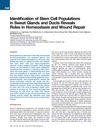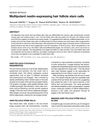Multipotent Nestin-Positive Stem Cells Reside in the Stroma of Human Eccrine and Apocrine Sweat Glands and Can Be Propagated Robustly In Vitro
October 2013
in “
PloS one
”
TLDR Human sweat glands have a type of stem cell that can grow well and turn into different cell types.
The 2013 study discovered that human sweat glands contain multipotent Nestin-positive stem cells, also known as sweat gland stroma-derived stem cells (SGSCs), in their stroma. These cells were found in both eccrine and apocrine sweat glands of human axillary skin. The researchers successfully propagated these cells in vitro, and found that 80% of isolated SGSCs expressed Nestin, had a high proliferation capacity, and could differentiate into various cell types. The SGSCs also demonstrated a pronounced ectodermal differentiation and secreted prominent cytokines, indicating their immunological potential. The study concluded that human sweat glands are a source of unique stem cells with potential for clinical therapies due to the easy accessibility of skin tissue biopsies. The study involved SGSCs from 6 different donors to account for patient variability.



